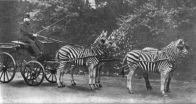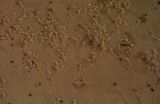(Press-News.org) We all think we have a rough idea of what happened 12,000 years ago when people at several different spots around the globe brought plants under cultivation and domesticated animals for transport, food or fiber. But how much do we really know?
Recent research suggests less than we think. For example, why did people domesticate a mere dozen or so of the roughly 200,000 species of wild flowering plants? And why only about five of the 148 species of large wild mammalian herbivores or omnivores? And while we're at it, why haven't more species of either plants or animals been domesticated in modern times?
If nothing else, the tiny percentages of domesticates suggests there are limitations to human agency, and that it almost certainly is not true that people can step in and completely remodel through artificial selection an organism shaped for millennia by natural selection.
The small number of domesticates is just one of many questions raised in a special issue of the Proceedings of the National Academy of Sciences published online April 21.
The issue is the product of a 2011 meeting of scholars with an interest in domestication at the National Evolutionary Synthesis Center, a nonprofit science center jointly operated by Duke University, the University of North Carolina at Chapel Hill and North Carolina State University.
Of the 25 scholars at the conference, two were from Washington University in St. Louis: Arts & Sciences' Fiona Marshall, PhD, professor of archaeology, who studies animal domestication, and Kenneth Olsen, PhD, associate professor of biology, who studies plant domestication.
Both Marshall and Olsen are currently engaged in research on the crumbling margins of domestication where questions about this evolutionary process loom the largest.
Marshall studies two species that are famously ambivalently domesticated: donkeys and cats. Olsen studies rice and cassava and is currently interested in rice mimics, weeds that look enough like rice that they fly under the radar even when rice fields are handweeded.
Both Marshall and Olsen contributed articles to the special PNAS issue (see The story of animal domestication retold and Genetic study tackles mystery of slow plant domestications) and helped write the introductory essay that raises the big questions confronting the field.
"This workshop was especially fun," said Olsen, "because it brought together people working on plants and animals and archeologists and geneticists. I hadn't really thought much about animal domestication because I work primarily with plants, so it was exciting to see the same problem from a very different perspective."
How much of it was our doing?
Many of our ideas about domestication are derived from modern experience with animal breeding. Anyone familiar with the huge variety of dog breeds, all of which belong to the same subspecies of the gray wolf, has some appreciation of the power of selective breeding to alter appearance and behavior.
But what about self-fertilizing or wind-pollinated plants, or for that matter, domesticated animals accidentally or deliberately bred with wild relatives?
Recent evidence that cereal crops, such as wheat or barley, evolved domestication traits much more slowly than had been thought has led to renewed interest in the idea that selection during domestication may have been partly accidental.
Charles Darwin himself drew a distinction between conscious selection, in which humans directly select for desirable traits, and unconscious selection, where traits evolve as a byproduct of natural selection in crop fields or from selection on other traits.
"The big focus right now is how much unintentional change people were causing environmentally that resulted in natural selection altering both plants and animals," said Marshall.
"We used to think cats and dogs were real outliers in the animal domestication process because they were attracted to human settlements for food and in some sense domesticated themselves. But new research is showing that other domesticated animals may be more like cats and dogs than we thought.
"Once animals such as donkeys or cattle were caught," Marshall said, "the changes humans sought to make were pretty minimal. Really it just came down to culling a few of the males and breeding all of the females."
Even today, she points out, African pastoralists can afford to kill only four out of every 100 cows or they run the risk that drought and disease will wipe out the entire herd. "So I think outside of industrialized societies or special situations, artificial selection was very weak," she said.
"In the donkeys and other transport animals, it's not affiliative [tame] behavior the herders want," Marshall said. "What they care about more than anything else is that their animals stay alive."
So artificial selection is acting in the same direction as natural selection, or maybe pushing even harder, because humans often place animals in harsher conditions than natural ones.
"The comparable idea for plants," said Olsen, "is the dump heap hypothesis, originally proposed by Edgar Anderson, a botany professor here at Washington University. The idea is that when people threw out the refuse of plant foods, including seeds, some grew and again set seed, and in this way people inadvertently selected species they were eating that also did well in the disturbed and nutrient-rich environment of the dump heap."
"Cultivation practices play a huge role in selection," said Olsen. "Traditionally in Southeast Asia, many different varieties of rice were grown simultaneously in a given field. It was a bet-hedging strategy," he said, "that ensured some plants would survive and produce seed even in a bad season." So it wasn't people selecting the crop plants directly so much as people changing the landscape in ways that altered the selection pressure on plants.
How best to time travel
Questions about the original domestication events are difficult to answer because plants and animals were domesticated before humans invented writing, and so figuring out what happened has been a matter of making do with the limited evidence that has survived.
The problem is particularly difficult for animal domestication because what matters most is animal behavior, which leaves few traces. In the past, scientists tried measuring bones or examining teeth, looking for age or size differences or pathology that might plausibly be related to animals living with people.
"Sometimes there aren't morphological shifts that are easy to find or they're too late to tell us anything," Marshall said. "We've gone away from morphological identifiers of domestication, and we're going with behavior now, however we can get it. If we've got concentrations of dung, that means animals were being corralled," she said.
Olsen, on the other hand, seeks to identify genes in modern crop species that are associated with domestication traits in the plant, such as an erect rather than a sprawling architecture. The techniques used to isolate these genes are difficult and time consuming and may not always penetrate as deeply into the past as scientists had once assumed because present-day plants are only a subset of the crop varieties that may have once existed.
So both Marshall and Olsen are excited by recent successes in sequencing ancient DNA. Ancient DNA, they say, will allow hypotheses about domestication to be tested over the entire evolutionary time period of domestication.
Another only recently appreciated clue to plant domestication is the presence of enriched soils, created through human activities. One example is the terra preta in the Amazon basin, which bears silent witness to the presence of a pre-Columbian agricultural society in what had been thought to be untouched forest.
By mapping distributions of enriched soils, scientists hope to better understand how ancient people altered landscapes and the effects that had on plant communities.
"It is really clear," Marshall said, "that we need all the different approaches that we can possibly get in order to triangulate back. We're using all kinds of ways, coarse-grained and fine, long-term and short, because the practical implications for us are quite great."
After all, the first domestications may have been triggered by climate change at the end of the last ice age — in combination with social issues.
As a result, people abandoned the hunter-gatherer lifestyle they had successfully followed for 95 percent of human history and turned instead to the new strategies of farming and herding.
As we head into a new era of climate change, Marshall said it would be comforting to know that we understood what happened then and why.
INFORMATION:
"The Modern View of Domestication," a special issue of PNAS edited by Greger Larson and Dolores R. Piperno, resulted from a meeting titled "Domestication as an Evolutionary Phenomenon: Expanding the Synthesis," held April 7–11, 2011, that was funded and hosted by the National Evolutionary Synthesis Centre (National Science Foundation EF-0905606) in 2011.
More questions than answers as mystery of domestication deepens
In recent decades, research has unraveled much of what we thought we knew about this crucial event in human history
2014-04-21
ELSE PRESS RELEASES FROM THIS DATE:
NNI researchers discover novel function of protein linked to Alzheimer's disease
2014-04-21
Singapore, 19 April 2014 – A research team led by the National Neuroscience Institute (NNI) has uncovered a novel function of the Amyloid Precursor Protein (APP), one of the main pathogenic culprits of Alzheimer's disease. This discovery may help researchers understand how the protein goes awry in the brains of Alzheimer's disease patients, and potentially paves the way for the development of innovative therapeutics to improve the brain function of dementia patients.
The findings were published in the prestigious scientific research journal Nature Communications last ...
Financial incentives help economically-disadvantaged pregnant smokers quit and improve fetal growth
2014-04-21
Smoking during pregnancy – particularly among economically-disadvantaged women – leads to a host of poor pregnancy outcomes, including miscarriage, preterm birth, SIDS, and additional adverse effects later in life. Without a formal treatment intervention, women in this population continue to smoke, and their babies suffer. Vermont Center on Behavior and Health Director Stephen Higgins, Ph.D., and colleagues, have developed an effective behavioral economic approach that offers women financial incentives for quitting.
The groups' most recent findings, published online ...
Big data poses great challenges and opportunities for databases
2014-04-21
Advances in the technology frontier have resulted in major disruptions and transformations in the massive data processing infrastructures. For the past three decades, classical database management systems, data warehousing and data analysis technologies have been well recognized as effective tools for data management and analysis. More recently, data from different sources and in different format are being collected at unprecedented scale. This gives rise to the so-called 3V characteristics of the big data: volume, velocity and variety. Classical approaches of data warehousing ...
Why alcoholism saps muscle strength
2014-04-21
(PHILADELPHIA) -- Muscle weakness is a common symptom of both long-time alcoholics and patients with mitochondrial disease. Now researchers have found a common link: mitochondria that are unable to self-repair. The results will be published online April 21 in The Journal of Cell Biology. The link to self-repair provides researchers both a new way to diagnose mitochondrial disease, and a new drug target.
Mitochondria -- organelles that produce the energy needed for muscle, brain, and every other cell in the body -- repair their broken components by fusing with other mitochondria ...
Amino-functionalized carbon nanotubes act as a carrier for nerve growth factor
2014-04-21
In recent years, there are growing studies concerning the use of different carrier materials for sustained-release and controlled-release of nerve growth factor in neuroscience research. In a study by Prof. Gao Li and team from Tongji Medical College, Huazhong University of Science and Technology in China, amino-functionalized ethylenediamine-treated multi-walled carbon nanotubes were used to prepare carbon nanotubes-nerve growth factor complexes by non-covalent grafting. Results showed that amino functionalization improved carbon nanotubes-nerve growth factor complex dispersibility, ...
People selectively remember the details of atrocities that absolve in-group members
2014-04-21
Conversations about wartime atrocities often omit certain details. According to research published in Psychological Science, a journal of the Association for Psychological Science, these omissions can lead people to have different memories for the event depending on social group membership.
"We started thinking about this project around the time when stories began to emerge in the popular media about atrocities committed by American soldiers in Iraq and Afghanistan," says lead researcher Alin Coman, psychological scientist at Princeton University.
"We wanted to scientifically ...
A new key to unlocking the mysteries of physics? Quantum turbulence
2014-04-21
The recent discovery of the Higgs boson has confirmed theories about the origin of mass and, with it, offered the potential to explain other scientific mysteries.
But, scientists are continually studying other, less-understood forces that may also shed light on matters not yet uncovered. Among these is quantum turbulence, writes Katepalli Sreenivasan, an NYU University Professor, in a special issue of Proceedings of the National Academy of Sciences.
Sreenivasan's introductory analysis, written with issue co-editors Carlo Barenghi of Newcastle University and Ladislav ...
Mental illness not usually linked to crime, research finds
2014-04-21
WASHINGTON — In a study of crimes committed by people with serious mental disorders, only 7.5 percent were directly related to symptoms of mental illness, according to new research published by the American Psychological Association.
Researchers analyzed 429 crimes committed by 143 offenders with three major types of mental illness and found that 3 percent of their crimes were directly related to symptoms of major depression, 4 percent to symptoms of schizophrenia disorders and 10 percent to symptoms of bipolar disorder.
"When we hear about crimes committed by people ...
Teachers' scare tactics may lead to lower exam scores
2014-04-21
WASHINGTON -- As the school year winds down and final exams loom, teachers may want to avoid reminding students of the bad consequences of failing a test because doing so could lead to lower scores, according to new research published by APA.
"Teachers are desperately keen to motivate their students in the best possible way but may not be aware of how messages they communicate to students around the importance of performing well in exams can be interpreted in different ways," said lead author David Putwain, PhD, of Edge Hill University in Lancashire, England.
The study, ...
Ginseng can treat and prevent influenza and RSV, researcher finds
2014-04-21
ATLANTA--Ginseng can help treat and prevent influenza and respiratory syncytial virus (RSV), a respiratory virus that infects the lungs and breathing passages, according to research findings by a scientist in Georgia State University's new Institute for Biomedical Sciences.
In a recent issue of Nutrients and an upcoming publication of the International Journal of Molecular Medicine, Sang-Moo Kang reports the beneficial effects of ginseng, a well-known herbal medicine, on human health.
Kang's primary research focuses on designing and developing effective vaccines against ...
LAST 30 PRESS RELEASES:
Numbers in our sights affect how we perceive space
SIMJ announces global collaborative book project in commemoration of its 75th anniversary
Air pollution exposure and birth weight
Obstructive sleep apnea risk and mental health conditions among older adults
How talking slows eye movements behind the wheel
The Ceramic Society of Japan’s Oxoate Ceramics Research Association launches new international book project
Heart-brain connection: international study reveals the role of the vagus nerve in keeping the heart young
Researchers identify Rb1 as a predictive biomarker for a new therapeutic strategy in some breast cancers
Survey reveals ethical gaps slowing AI adoption in pediatric surgery
Stimulant ADHD medications work differently than thought
AI overestimates how smart people are, according to HSE economists
HSE researchers create genome-wide map of quadruplexes
Scientists boost cell "powerhouses" to burn more calories
Automatic label checking: The missing step in making reliable medical AI
Low daily alcohol intake linked to 50% heightened mouth cancer risk in India
American Meteorological Society announces Rick Spinrad as 2026 President-Elect
Biomass-based carbon capture spotlighted in newly released global climate webinar recording
Illuminating invisible nano pollutants: advanced bioimaging tracks the full journey of emerging nanoscale contaminants in living systems
How does age affect recovery from spinal cord injury?
Novel AI tool offers prognosis for patients with head and neck cancer
Fathers’ microplastic exposure tied to their children’s metabolic problems
Research validates laboratory model for studying high-grade serous ovarian cancer
SIR 2026 delivers transformative breakthroughs in minimally invasive medicine to improve patient care
Stem Cell Reports most downloaded papers of 2025 highlight the breadth and impact of stem cell research
Oxford-led study estimates NHS spends around 3% of its primary and secondary care budget on the health impacts of heat and cold in England
A researcher’s long quest leads to a smart composite breakthrough
Urban wild bees act as “microbial sensors” of city health.
New study finds where you live affects recovery after a hip fracture
Forecasting the impact of fully automated vehicle adoption on US road traffic injuries
Alcohol-related hospitalizations from 2016 to 2022
[Press-News.org] More questions than answers as mystery of domestication deepensIn recent decades, research has unraveled much of what we thought we knew about this crucial event in human history



